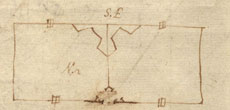
George Granger, Jr.'s name from a document, in which Jefferson lists him as a "smith" and gives his birth year.
George Granger, Jr., an enslaved blacksmith, worked in the smith’s shop and supervised the nailery. In 1773, Jefferson purchased 14-year-old Granger, as well as his mother, Ursula, and younger brother, Bagwell, from a Cumberland County plantation for £210. Granger’s father, George Granger, Sr., was purchased from nearby plantation for £130—the family was settled at Monticello, possibly in the “Negro quarter” on Mulberry Row. Granger first learned the blacksmithing trade from Francis Bishop, a white artisan hired by Jefferson in 1774 to run the blacksmithing shop at Shadwell and to train Monticello slaves. After Bishop’s departure in 1776, Granger ran the shop with another slave, Barnaby, until the arrival of the British deserter and blacksmith William Orr in 1781. After Orr left in 1783, Granger took charge of the Monticello blacksmith shop for the next 15 years—shoeing horses, repairing agricultural machinery, and making gun and vehicle parts. In 1794, when Jefferson began his nail-making enterprise in the smith’s shop, Granger became its manager and received a percentage of the profits. By all accounts, Granger was an effective manager. Thomas Mann Randolph told Jefferson that “I scarcely look to the Nailery at all - George I am sure could not stoop to my authority and I hope and believe he pushes your interests as well as I could.” But in 1798, Granger fell ill. Although Jefferson paid the doctor “Perkins’ Sam” $10 for “attendance on smith George,” the talented blacksmith died in early 1799.
This account is compiled from Lucia Stanton, “Those Who Labor for My Happiness:” Slavery at Thomas Jefferson's Monticello (University of Virginia Press and Thomas Jefferson Foundation, 2012).
Related People:
- George Granger, Sr., father
- Ursula Granger, mother
- Isaac Granger Jefferson, brother
"Negro quarter"
Learn more about this multi-family slave dwelling built ca. 1770.